Edelstein-Keshet L. Mathematical Models in Biology
Подождите немного. Документ загружается.

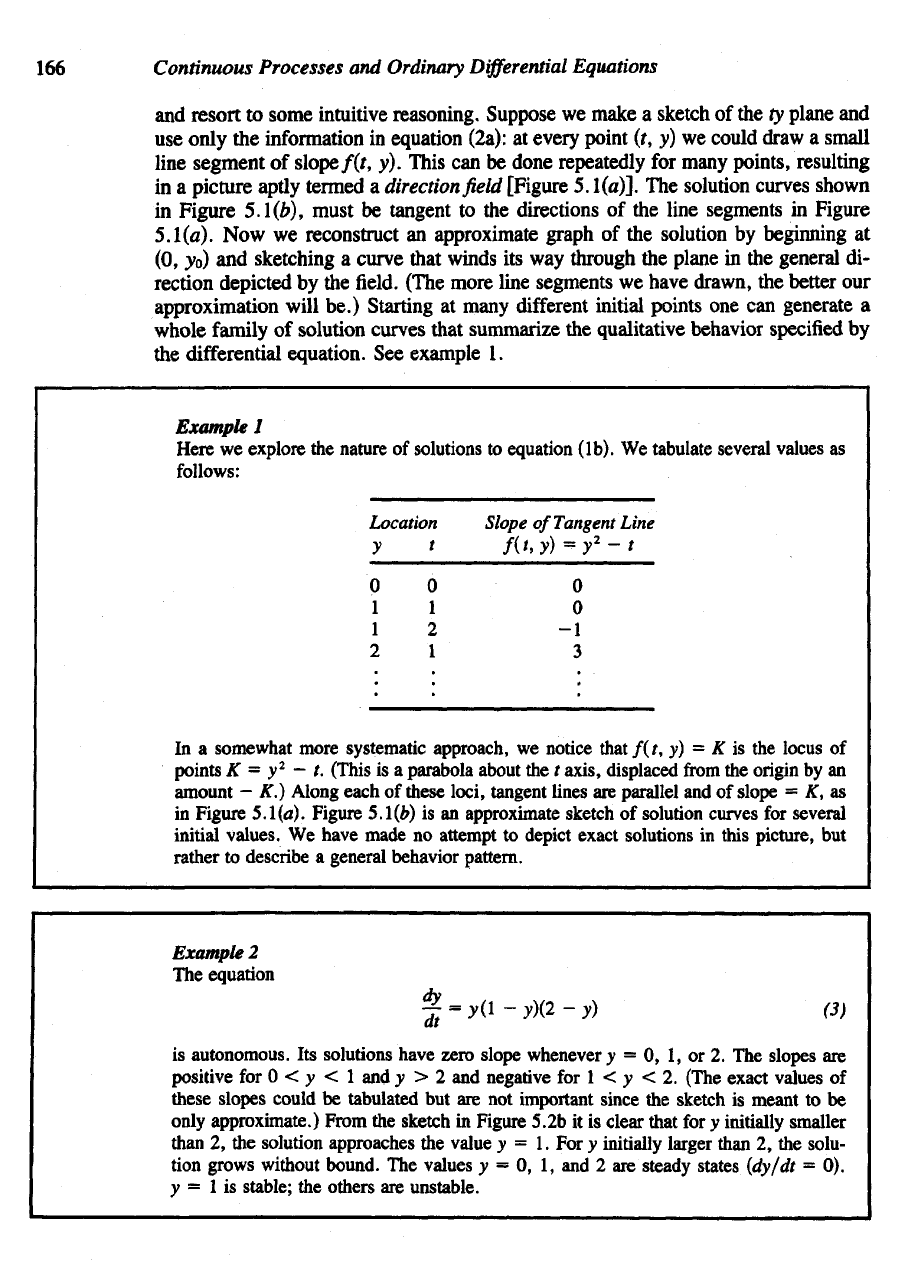
166
Continuous Processes
and
Ordinary
Differential
Equations
and
resort
to
some intuitive reasoning. Suppose
we
make
a
sketch
of the ty
plane
and
use
only
the
information
in
equation (2a):
at
every point
(t, y) we
could
draw
a
small
line segment
of
slope f(t,
y).
This
can be
done repeatedly
for
many
points, resulting
in
a
picture aptly termed
a
direction
field
[Figure
5.
l(a)j.
The
solution curves
shown
in
Figure 5.1(£),
must
be
tangent
to the
directions
of the
line segments
in
Figure
5.1
(a).
Now we
reconstruct
an
approximate graph
of the
solution
by
beginning
at
(0,
j/o)
and
sketching
a
curve
that
winds
its way
through
the
plane
in the
general
di-
rection depicted
by the field.
(The more line segments
we
have drawn,
the
better
our
approximation will be.) Starting
at
many
different
initial points
one can
generate
a
whole family
of
solution curves that summarize
the
qualitative behavior specified
by
the
differential equation.
See
example
1.
Example
1
Here
we
explore
the
nature
of
solutions
to
equation (Ib).
We
tabulate several values
as
follows:
Location
Slope
of
Tangent
Line
y
t
f(t,y)=y
2
-t
0
1
1
2
0
1
2
1
0
0
-1
3
In
a
somewhat more systematic approach,
we
notice
that/(f,
y) = K is the
locus
of
points
K = y
2
- t.
(This
is a
parabola about
the t
axis, displaced
from the
origin
by an
amount
- K.)
Along each
of
these
loci,
tangent lines
are
parallel
and of
slope
= K, as
in
Figure
5.1(0).
Figure
5.1(£)
is an
approximate sketch
of
solution curves
for
several
initial values.
We
have made
no
attempt
to
depict exact solutions
in
this picture,
but
rather
to
describe
a
general behavior pattern.
Example
2
The
equation
is
autonomous.
Its
solutions have zero slope whenever
y = 0, 1, or 2. The
slopes
are
positive
for 0 < y < 1 and y > 2 and
negative
for 1 < y < 2.
(The exact values
of
these
slopes
could
be
tabulated
but are not
important
since
the
sketch
is
meant
to be
only approximate.) From
the
sketch
in
Figure 5.2b
it is
clear
that
for y
initially
smaller
than
2, the
solution approaches
the
value
y = 1. For y
initially larger than
2, the
solu-
tion
grows without bound.
The
values
y = 0, 1, and 2 are
steady states
(dy/dt
= 0).
y
— 1 is
stable;
the
others
are
unstable.

Phase-Plane
Methods
and
Qualitative
Solutions
167
Figure
5.1
Solutions
to y' = y
2
- t.
(a)
For
each
pair
of
values
(t, y),
line segments whose slope
is
f(t,
y)
=
y
2
~ t are
shown.
(Note
that slopes
are
constant
along parabolic curves
for
which
K
= y
2
— t,
where
K is any
constant.)
(b)
Solution
curves
are
constructed
by
maintaining tangency
to
the
directions shown
in
(a).

168
Continuous
Processes
and
Ordinary
Differential
Equations
In
example
2, the
function
appearing
on the RHS of
equation
(3)
depends
ex-
plicitly
only
on y, not on t. A
system described
by
such
an
equation would
be un-
folding
at
some inherent rate independent
of the
clock
time or the
time
at
which
the
process
began.
The
differential
equation
is
said
to be
autonomous,
and
solutions
to it
can
be
represented
in an
especially
convenient way,
as
will presently
be
shown.
Figure
5.2
Solutions
toy'
= y(l -
y)(2
- y).
(a)
For
each value
ofy,
line segments bearing
the
slope
f(y)
= y(l —
y)(2
— y)
have been drawn.
The
slopes
are
zero when
y = 0, 1, or 2, and
positive
for
0<y<lory>3.(b)
Solution
curves
are
constructed
by
maintaining tangency
to
the
line segments drawn
in
(a).

Phase-Plane
Methods
and
Qualitative
Solutions
169
The
fact
that
a
differential equation
is
autonomous means, pictorially, that
the
tangent
line
segments
do not
"wobble"
along
the
time axis. This
can be
used
to
rep-
resent
the
same qualitative information
in a
more condensed
form.
Let us
suppress
the
time dependence
and
instead plot
dy/dt
as a
function
of y. See
Figure
5.3(a).
Whenever/(y)
is
positive (that
is, for 0 < y < 1 or y > 2), y
must
be
increasing.
Whenever /(y)
is
negative,
v
must
be
decreasing. This
can be
represented
by
draw-
ing
arrows pointing
to the
left
or to the
right directly along
the y
axis,
as
shown
in
Figure
5.3(b). This abbreviated representation
is
called
a
one-dimensional
phase
portrait,
or
&
phase
flow on a
line. Figure
5.3(fe)
conveys roughly
the
same qualita-
tive information
as
does Figure 5.2, with
the
omission
of the
time course,
or
speed
with
which
the
solution y(t) changes.
Figure
5.3 (a)
Graph
off(y)
versus
y for
equation
(3).
Since
y' =
f(y),
y is
increasing when
f is
positive, decreasing when
f is
negative,
and
stationary
when
f = 0. (b) The
qualitative features
described
in (a) can be
summarized
by
drawing
the
directions
of
motion along
the y
axis.
Example
3
again illustrates
the
procedure
of
extracting information
from
the
equation
and
depicting
the
solution
as a
one-dimensional
flow.
As
mentioned previously, when
a
differential
equation
is
autonomous,
the
qualitative behavior
of its
solutions
can be
characterized even
when
time
dependence
is
suppressed. Think
of a
qualitative solution
as a
trajectory:
a flow
that begins
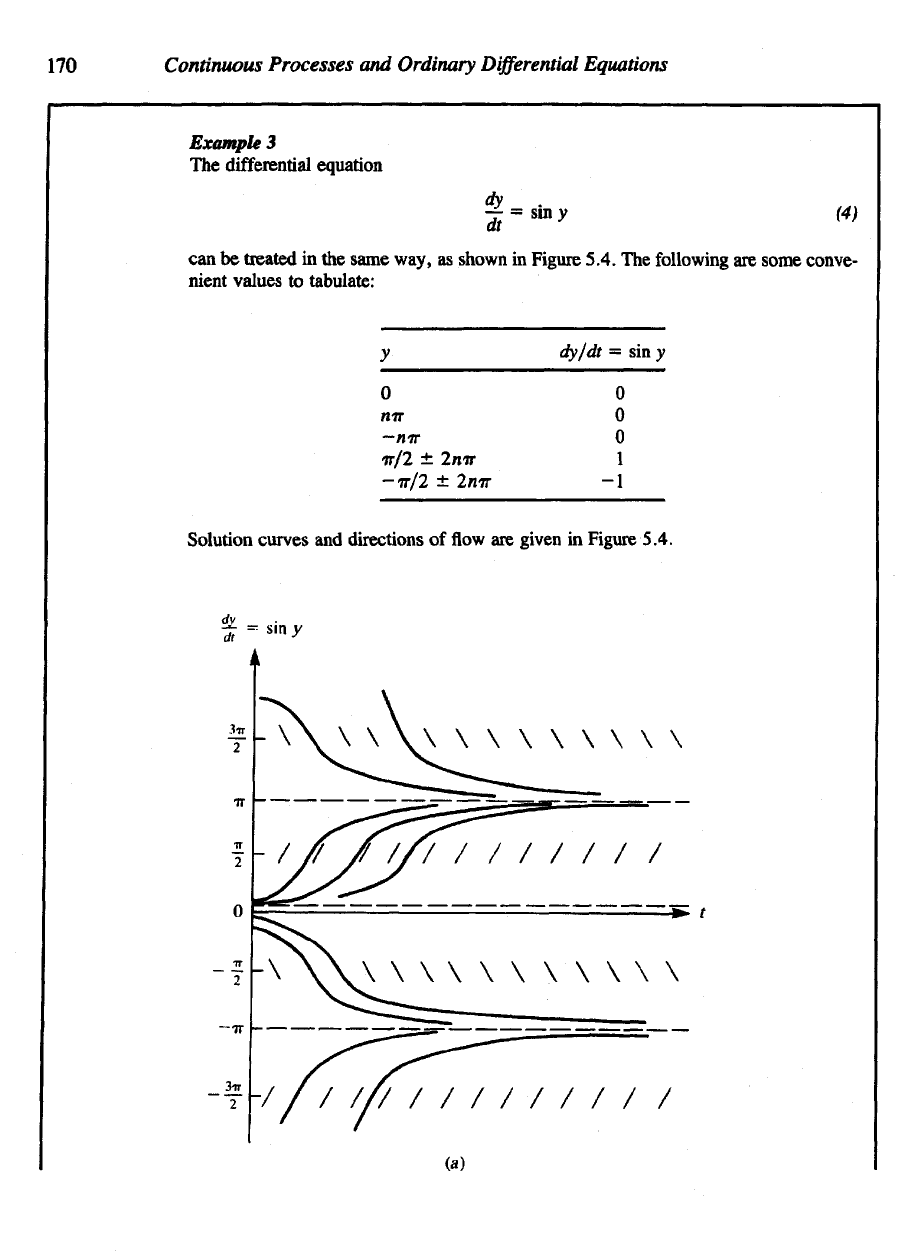
170
Continuous
Processes
and
Ordinary
Differential
Equations
Example
3
The
differential
equation
can be
treated
in the
same way,
as
shown
in
Figure 5.4.
The
following
are
some conve-
nient values
to
tabulate:
Solution curves
and
directions
of flow are
given
in
Figure 5.4.
y
0
ntr
—nir
ir/2
±
2nir
-it/2
±
2nir
dy/dt
= sin y
0
0
0
1
-1
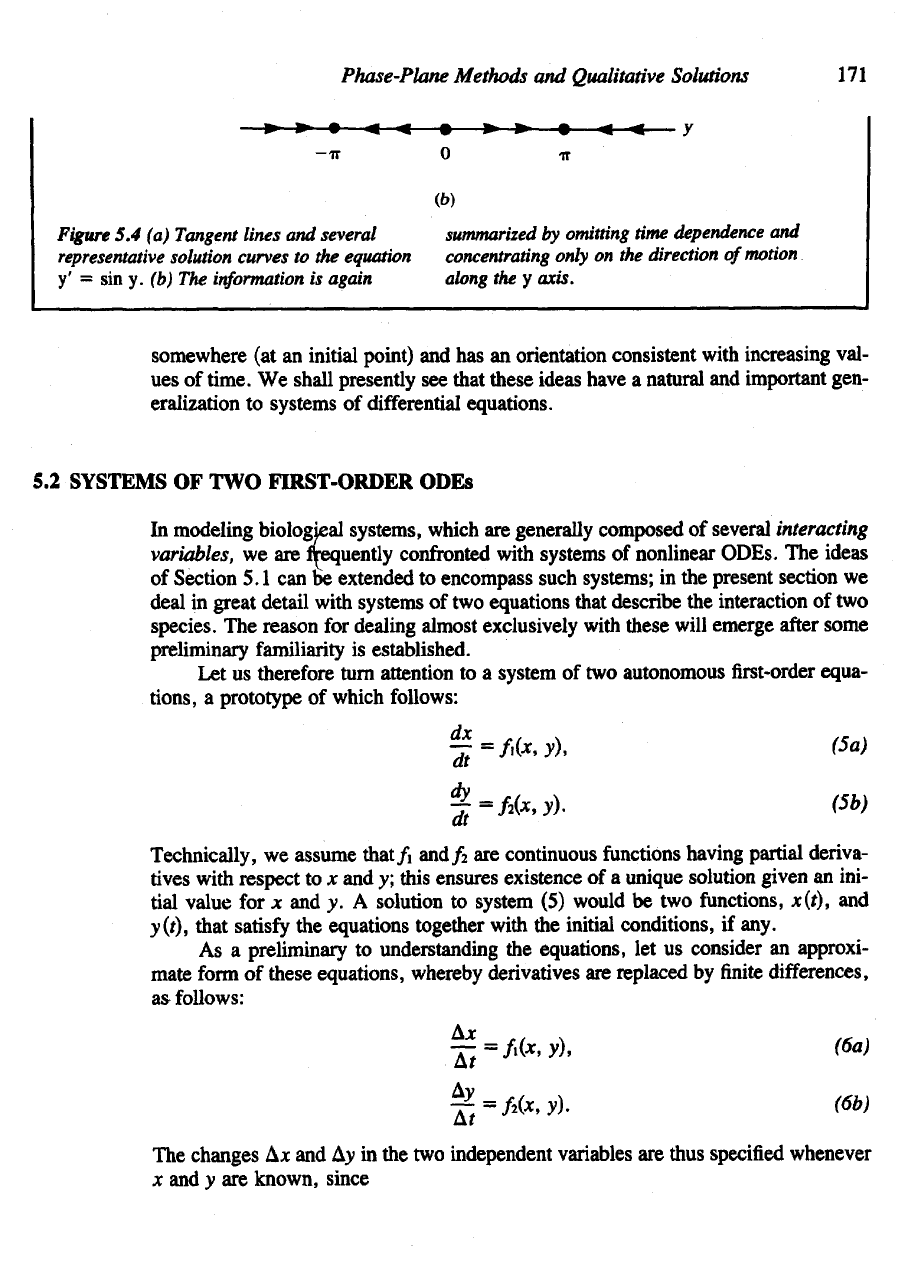
Phase-Plane
Methods
and
Qualitative
Solutions
171
Figure
5.4 (a)
Tangent lines
and
several summarized
by
omitting
time
dependence
and
representative
solution curves
to the
equation concentrating
only
on the
direction
of
motion
y' = sin y. (b) The
information
is
again
along
the y
axis.
somewhere
(at an
initial point)
and has an
orientation consistent
with
increasing val-
ues
of
time.
We
shall presently
see
that these ideas have
a
natural
and
important gen-
eralization
to
systems
of
differential equations.
5.2
SYSTEMS
OF TWO
FIRST-ORDER ODEs
In
modeling
biological
systems, which
are
generally composed
of
several interacting
variables,
we are
frequently confronted with systems
of
nonlinear ODEs.
The
ideas
of
Section
5.1 can be
extended
to
encompass such systems;
in the
present section
we
deal
in
great detail with systems
of two
equations that describe
the
interaction
of two
species.
The
reason
for
dealing almost exclusively with these will emerge
after
some
preliminary familiarity
is
established.
Let us
therefore turn attention
to a
system
of two
autonomous
first-order
equa-
tions,
a
prototype
of
which follows:
Technically,
we
assume
that/i
and/2
are
continuous functions having partial deriva-
tives
with
respect
to x and y;
this ensures
existence
of a
unique solution given
an
ini-
tial value
for x and y. A
solution
to
system
(5)
would
be two
functions, x(t),
and
y
(t),
that satisfy
the
equations together with
the
initial conditions,
if
any.
As
a
preliminary
to
understanding
the
equations,
let us
consider
an
approxi-
mate
form
of
these equations, whereby derivatives
are
replaced
by finite
differences,
a&
follows:
The
changes
A* and Ay in the two
independent varizbles are thus specified whenever
x and y are
known, since
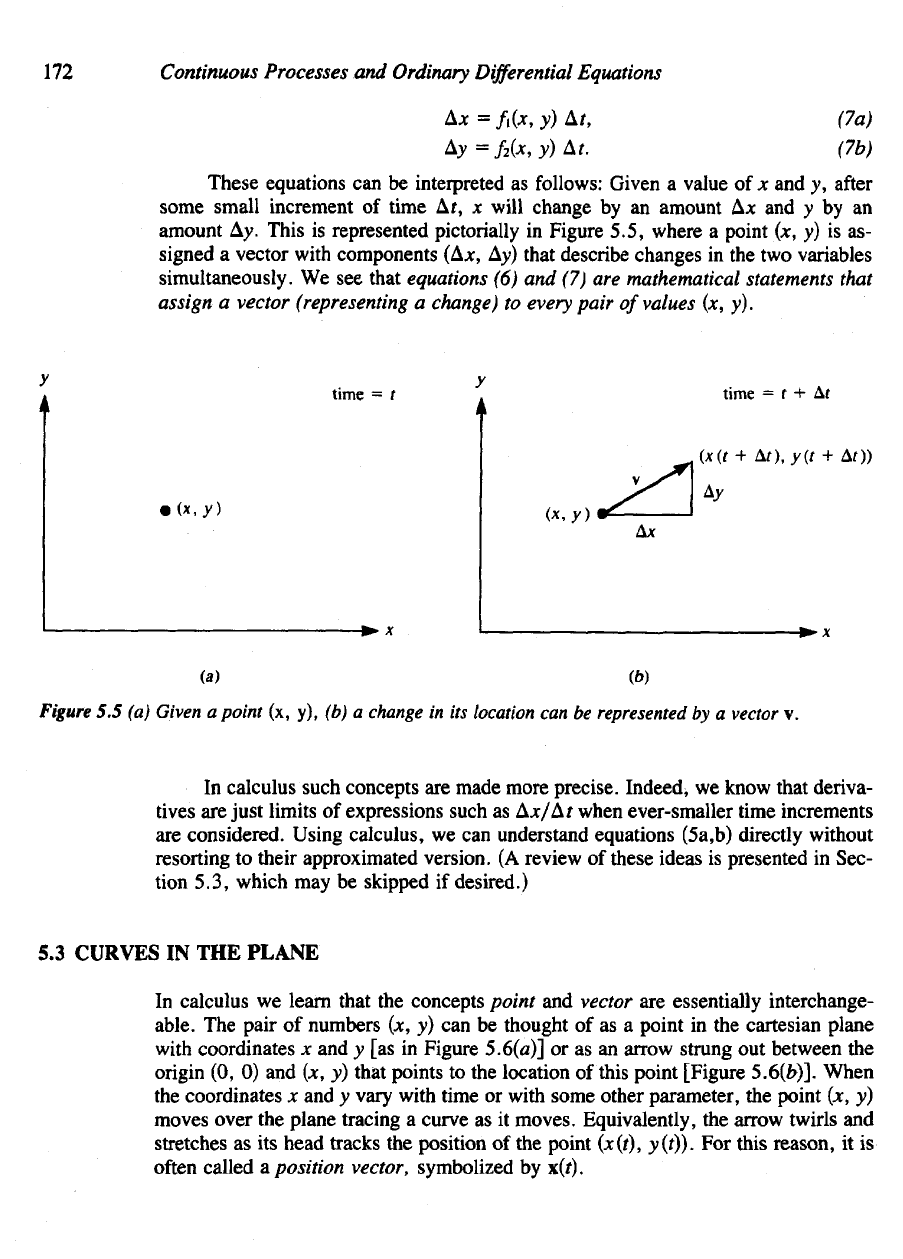
172
Continuous Processes
and
Ordinary
Differential
Equations
These equations
can be
interpreted
as
follows:
Given
a
value
of x and y,
after
some
small increment
of
time
Af, x
will change
by an
amount
AJC
and y by an
amount
Ay.
This
is
represented pictorially
in
Figure 5.5, where
a
point
(x, y) is as-
signed
a
vector
with
components (A*,
Ay)
that describe changes
in the two
variables
simultaneously.
We see
that equations
(6) and (7) are
mathematical statements that
assign
a
vector (representing
a
change)
to
every
pair
of
values
(x, y).
Figure
5.5 (a)
Given
a
point
(x, y), (b) a
change
in its
location
can be
represented
by a
vector
v.
In
calculus such concepts
are
made more
precise.
Indeed,
we
know that deriva-
tives
are
just limits
of
expressions such
as
A*/A/ when ever-smaller time increments
are
considered. Using calculus,
we can
understand equations (5a,b) directly without
resorting
to
their approximated version.
(A
review
of
these ideas
is
presented
in
Sec-
tion 5.3, which
may be
skipped
if
desired.)
5.3
CURVES
IN THE
PLANE
In
calculus
we
learn that
the
concepts point
and
vector
are
essentially interchange-
able.
The
pair
of
numbers (jc,
y) can be
thought
of as a
point
in the
cartesian plane
with
coordinates
x and y [as in
Figure
5.6(a)]
or as an
arrow strung
out
between
the
origin
(0, 0) and (x, y)
that
points
to the
location
of
this
point
[Figure
5.6(&)]. When
the
coordinates
x and y
vary with time
or
with some other parameter,
the
point
(x, y)
moves over
the
plane tracing
a
curve
as it
moves. Equivalently,
the
arrow twirls
and
stretches
as its
head
tracks
the
position
of the
point
(x(t),
y(t)).
For
this
reason,
it is
often
called
a.
position vector, symbolized
by
x(f).
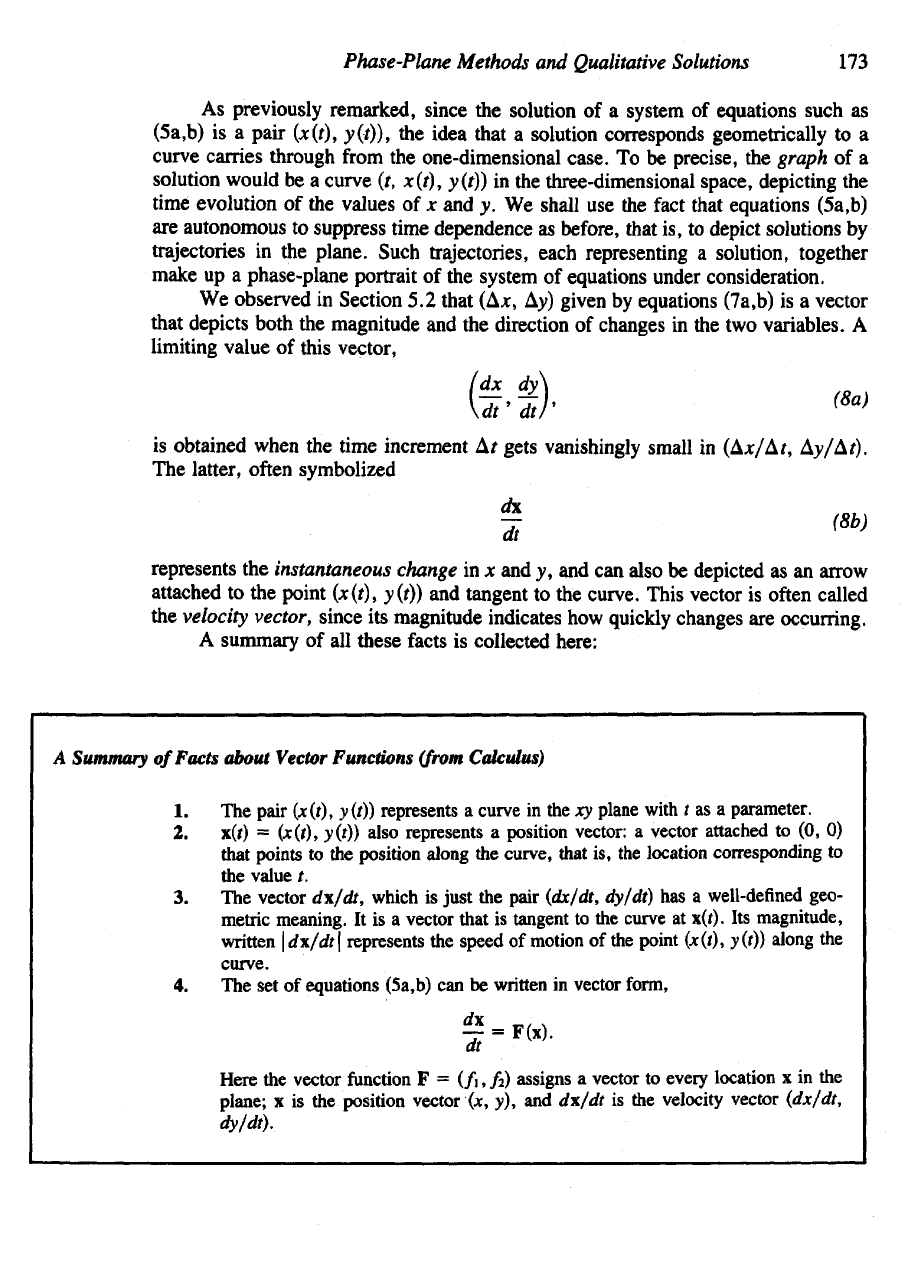
Phase-Plane
Methods
and
Qualitative Solutions
173
As
previously remarked, since
the
solution
of a
system
of
equations such
as
(5a,b)
is a
pair
(x(t),
y(/)),
the
idea that
a
solution corresponds geometrically
to a
curve
carries
through
from
the
one-dimensional case.
To be
precise,
the
graph
of a
solution would
be a
curve
(t,
x(t), y(t))
in the
three-dimensional space, depicting
the
time evolution
of the
values
of x and y. We
shall
use the
fact
that equations (5a,b)
are
autonomous
to
suppress time dependence
as
before, that
is, to
depict solutions
by
trajectories
in the
plane. Such trajectories, each representing
a
solution,
together
make
up a
phase-plane portrait
of the
system
of
equations under consideration.
We
observed
in
Section
5.2
that (A*,
Ay)
given
by
equations (7a,b)
is a
vector
that
depicts both
the
magnitude
and the
direction
of
changes
in the two
variables.
A
limiting
value
of
this vector,
is
obtained
when
the
time increment
Af
gets vanishingly small
in
(Ax/Ar,
Ay/Af).
The
latter, often symbolized
represents
the
instantaneous change
in x and y, and can
also
be
depicted
as an
arrow
attached
to the
point
(x(t),
y(f))
and
tangent
to the
curve. This vector
is
often
called
the
velocity
vector, since
its
magnitude indicates
how
quickly changes
are
occurring.
A
summary
of all
these
facts
is
collected
here:
A
Summary
of
Facts
about
Vector
Functions
(from
Calculus)
1. The
pair
(x(t),
y(t))
represents
a
curve
in the xy
plane
with
t as a
parameter.
2.
x(f)
=
(x(t),
y(t)) also
represents
a
position
vector:
a
vector
attached
to (0, 0)
that
points
to the
position along
the
curve,
that
is, the
location
corresponding
to
the
value
t.
3. The
vector
d\/dt,
which
is
just
the
pair
(dx/dt,
dy/dt)
has a
well-defined
geo-
metric
meaning.
It is a
vector
that
is
tangent
to the
curve
at
x(f).
Its
magnitude,
written
\d\fdt\
represents
the
speed
of
motion
of the
point
(x(t),
y(t))
along
the
curve.
4. The set of
equations (5a,b)
can be
written
in
vector
form,
Here
the
vector
function
F =
(f\,
/
2
)
assigns
a
vector
to
every
location
x in the
plane;
x is the
position vector
(x, y), and
d\/dt
is the
velocity
vector
(dx/dt,
dy/dt).
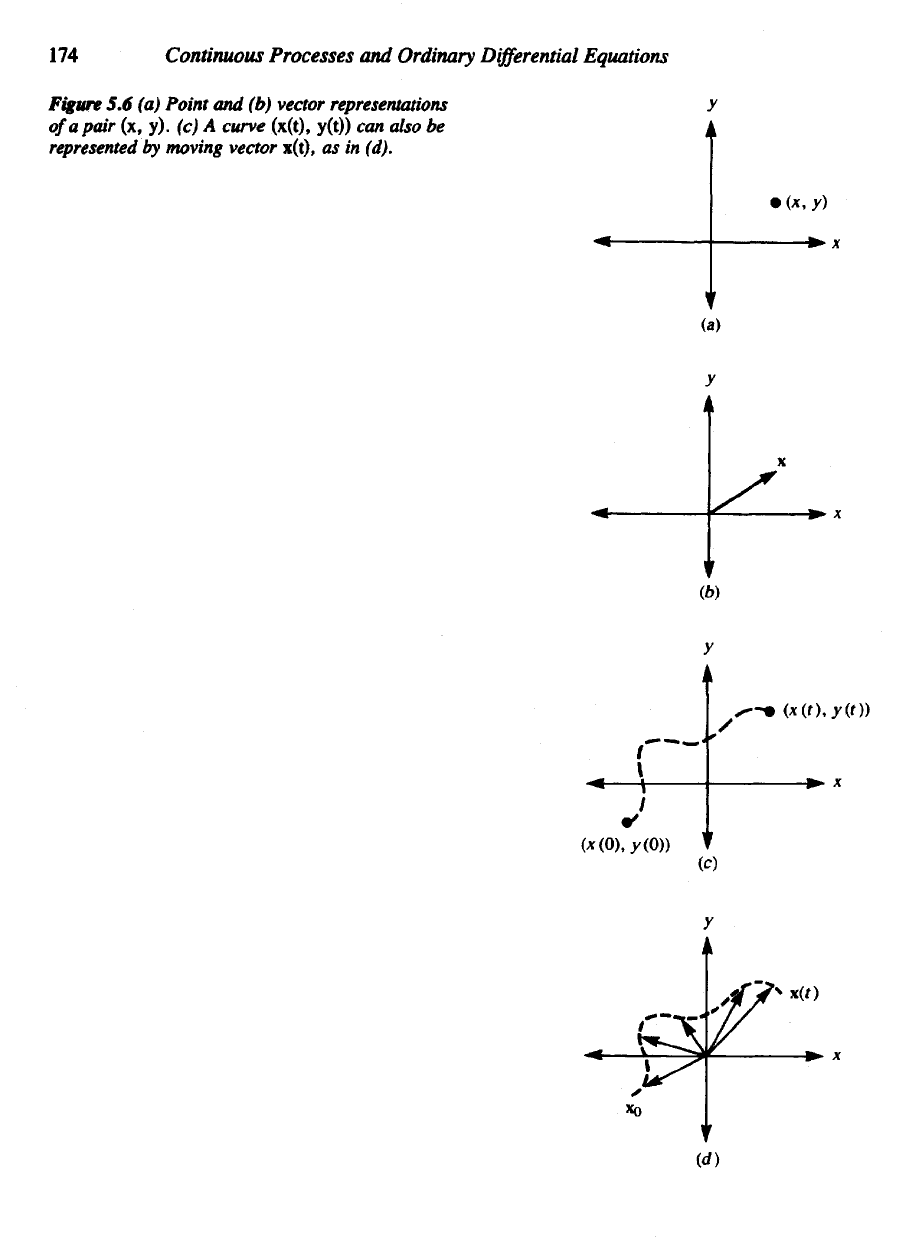
174
Continuous Processes
and
Ordinary
Differential
Equations
Figure
5.6 (a)
Point
and (b)
vector representations
of
a
pair
(x, y). (c) A
curve
(x(t),
y(t))
can
also
be
represented
by
moving vector
x(t),
as in
(d).

Phase-Plane
Methods
and
Qualitative
Solutions
175
5.4 THE
DIRECTION FIELD
From
c
that arise
in
calculus
we
surmise that solutions
to
ODEs, whether
in
one
dimension
or
higher, correspond
to
curves,
and
differential equations
are
"recipes"
for
tangent vectors
to
these curves. This insight will
now be
applied
to re-
constructing
a
qualitative picture
of
solutions
to a
system
of two
equations such
as
(5).
For
such autonomous systems each point
(x, y) in the
plane
is
assigned
a
unique
vector
(fi(x,
v),
f
2
(x,
y))
that does
not
change
with
time.
A
solution curve passing
through
(jc,
v)
must have these vectors
as its
tangents. Thus
a
collection
of
such vec-
tors
defines
a
direction
field,
which
can be
used
as a
visual guide
in
sketching
a
fam-
ily
of
solution curves, collectively
a
phase-plane portrait. Example
4
clarifies
how
this
is
done
in
practice.
After
tabulating arbitrarily many values
of (x, y) and the
corresponding values
of
f\(x,
y)
and/
2
(jc,
y), we are
ready
to
construct
the
direction
field. To
each point
(x,
y) we
attach
a
small
line
segment
in the
direction
of the
vector
(fi(x,
y),/2(x, y)).
Example
4
Let
and
let/iOc,
y) = xy —
y,/2(x,
y) = xy — x. In the
following
table
the
values
of/i
and
/2
are
listed
for
several values
of (x, y).
X
0
0
1
-1
0
1
1
-2
y
0
i
0
0
__
i
i
-i
-i
MX,
y)
0
-i
0
0
i
0
2
3
h(x,
y)
0
0
-1
1
0
0
-2
4
